Biogas Production from Anaerobic Co-Digestion of Spent Mushroom Substrate with Different Livestock Manure
Abstract
1. Introduction
2. Materials and Method
2.1. Feedstock and Inoculum
2.2. Experimental Setup
2.3. Design of Experiment
2.3.1. Anaerobic Co-Digestion of SMS and Different Manures
2.3.2. Anaerobic Co-Digestion of SMS and Chicken Manure (CM)
2.4. Analytical Methods
2.5. Data Analysis
3. Results and Discussion
3.1. Methane Production Performance of Co-Digestion of SMS and Different Livestock Manures
3.2. Gas Production Performance of Anaerobic Co-Digestion of SMS and Chicken Manure
3.2.1. Methane Production at Different Initial TS Content and Feedstock Ratio
3.2.2. VFAs Content
3.2.3. The Removal Efficiency of TS and VS
3.2.4. Synergetic Analysis of Co-Digestion at Different TS and Feedstock Ratios
3.2.5. Process Combination Optimization of AD Process
Regression Model
Graphical Analysis about the Effect of Interaction Factors
Optimum Conditions for Anaerobic Co-Digestion of SMS and CM
4. Conclusions
Author Contributions
Funding
Informed Consent Statement
Data Availability Statement
Acknowledgments
Conflicts of Interest
Abbreviations
| AD | Anaerobic Digestion |
| CG | Control Group |
| CM | Chicken Manure |
| CMY | Cumulative methane yield |
| DBY | Daily biogas yield |
| DM | Dairy Manure |
| GHG | Greenhouse Gas |
| HCL | Chloridric acid |
| LM | Livestock Manure |
| NaOH | Sodium Hydroxide |
| NH4+-N | Ammonia Nitrogen |
| PH | Potential Hydrogen |
| PM | Pig Manure |
| SMS | Spent Mushroom Substrate |
| SIMY | Synergistic increased methane yield |
| TS | Total Solids |
| VFA | Volatile Fatty Acid |
| VS | Volatile solids |
| WMP | Weighted methane production |
References
- Williams, B.; McMullan, J.; McCahey, S. An initial assessment of spent mushroom compost as a potential energy feedstock. Bioresour. Technol. 2001, 79, 227–230. [Google Scholar] [CrossRef]
- Zhu, J.; Han, M.; Zhang, G.; Yang, L. Co-digestion of spent mushroom substrate and corn stover for methane production via solid-state anaerobic digestion. J. Renew. Sustain. Energy 2015, 7, 023135. [Google Scholar] [CrossRef]
- Li, G.; Lu, Z.; Zhang, J.; Li, H.; Zhou, Y.; Zayan, A.M.I.; Huang, Z. Life cycle assessment of biofuel production from microalgae cultivated in anaerobic digested wastewater. Int. J. Agric. Biol. Eng. 2020, 13, 241–246. [Google Scholar] [CrossRef]
- Li, G.; Bai, X.; Li, H.; Lu, Z.; Zhou, Y.; Wang, Y.; Cao, J.; Huang, Z. Nutrients removal and biomass production from anaerobic digested effluent by microalgae: A review. Int. J. Agric. Biol. Eng. 2019, 12, 8–13. [Google Scholar] [CrossRef]
- Coles, P.S.; Nogin, G.; Fidanza, M.A.; Roth, G. Evaluation of Fresh Mushroom Compost in a Field Corn Production System. Compos. Sci. Util. 2020, 28, 76–86. [Google Scholar] [CrossRef]
- Meng, L.; Li, W.; Zhang, S.; Wu, C.; Lv, L. Feasibility of co-composting of sewage sludge, spent mushroom substrate and wheat straw. Bioresour. Technol. 2017, 226, 39–45. [Google Scholar] [CrossRef] [PubMed]
- Zhang, R.-H.; Duan, Z.; Li, Z.-G. Use of Spent Mushroom Substrate as Growing Media for Tomato and Cucumber Seedlings. Pedosphere 2012, 22, 333–342. [Google Scholar] [CrossRef]
- Yadav, M.; Singh, A.; Balan, V.; Pareek, N.; Vivekanand, V. Biological treatment of lignocellulosic biomass by Chaetomium globosporum: Process derivation and improved biogas production. Int. J. Biol. Macromol. 2019, 128, 176–183. [Google Scholar] [CrossRef]
- Bisaria, R.; Madan, M.; Mukhopadhyay, S.N. Production of biogas from residues from mushroom cultivation. Biotechnol. Lett. 1983, 5, 811–812. [Google Scholar] [CrossRef]
- Bisaria, R.; Vasudevan, P.; Bisaria, V. Utilization of spent agro-residues from mushroom cultivation for biogas production. Appl. Microbiol. Biotechnol. 1990, 33, 607–609. [Google Scholar] [CrossRef]
- Xiao, Z.; Lin, M.; Fan, J.; Chen, Y.; Zhao, C.; Liu, B. Anaerobic digestion of spent mushroom substrate under thermophilic conditions: Performance and microbial community analysis. Appl. Microbiol. Biotechnol. 2018, 102, 499–507. [Google Scholar] [CrossRef] [PubMed]
- YuanFang, D.; Ling, Q.; QuanPing, S.; LiangXiao, J.; Am, H.A. Influence of anaerobic co-digestion of mushroom cultivation wastes and pig manure on the biogas production and its quality. J. Agro-Environ. Sci. 2012, 31, 613–619. [Google Scholar]
- Shi, X.-S.; Yuan, X.-Z.; Wang, Y.-P.; Zeng, S.-J.; Qiu, Y.-L.; Guo, R.-B.; Wang, L.-S. Modeling of the methane production and pH value during the anaerobic co-digestion of dairy manure and spent mushroom substrate. Chem. Eng. J. 2014, 244, 258–263. [Google Scholar] [CrossRef]
- Lin, Y.; Ge, X.; Li, Y. Solid-state anaerobic co-digestion of spent mushroom substrate with yard trimmings and wheat straw for biogas production. Bioresour. Technol. 2014, 169, 468–474. [Google Scholar] [CrossRef] [PubMed]
- Li, Y.; Li, Y.; Zhang, D.; Li, G.; Lu, J.; Li, S. Solid state anaerobic co-digestion of tomato residues with dairy manure and corn stover for biogas production. Bioresour. Technol. 2016, 217, 50–55. [Google Scholar] [CrossRef] [PubMed]
- Luo, X.; Yuan, X.; Wang, S.; Sun, F.; Hou, Z.; Hu, Q.; Zhai, L.; Cui, Z.; Zou, Y. Methane production and characteristics of the microbial community in the co-digestion of spent mushroom substrate with dairy manure. Bioresour. Technol. 2018, 250, 611–620. [Google Scholar] [CrossRef]
- Yang, L.; Xu, F.; Ge, X.; Li, Y. Challenges and strategies for solid-state anaerobic digestion of lignocellulosic biomass. Renew. Sustain. Energy Rev. 2015, 44, 824–834. [Google Scholar] [CrossRef]
- Ballesteros, M. Enzymatic hydrolysis of lignocellulosic biomass. Bioalcohol Prod. 2010, 159–177. [Google Scholar] [CrossRef]
- Zhu, Q.; Dai, L.; Wang, Y.; Tan, F.; Chen, C.; He, M.; Maeda, T. Enrichment of waste sewage sludge for enhancing methane production from cellulose. Bioresour. Technol. 2021, 321, 124497. [Google Scholar] [CrossRef]
- Zheng, Z.; Liu, J.; Yuan, X.; Wang, X.; Zhu, W.; Yang, F.; Cui, Z. Effect of dairy manure to switchgrass co-digestion ratio on methane production and the bacterial community in batch anaerobic digestion. Appl. Energy 2015, 151, 249–257. [Google Scholar] [CrossRef]
- Shen, J.; Yan, H.; Zhang, R.; Liu, G.; Chen, C. Characterization and methane production of different nut residue wastes in anaerobic digestion. Renew. Energy 2018, 116, 835–841. [Google Scholar] [CrossRef]
- Ma, X.; Jiang, T.; Chang, J.; Tang, Q.; Luo, T.; Cui, Z. Effect of Substrate to Inoculum Ratio on Biogas Production and Microbial Community During Hemi-Solid-State Batch Anaerobic Co-digestion of Rape Straw and Dairy Manure. Appl. Biochem. Biotechnol. 2019, 189, 884–902. [Google Scholar] [CrossRef] [PubMed]
- Li, K.; Liu, R.; Sun, C. Comparison of anaerobic digestion characteristics and kinetics of four livestock manures with different substrate concentrations. Bioresour. Technol. 2015, 198, 133–140. [Google Scholar] [CrossRef] [PubMed]
- Xu, F.; Wang, Z.-W.; Tang, L.; Li, Y. A mass diffusion-based interpretation of the effect of total solids content on solid-state anaerobic digestion of cellulosic biomass. Bioresour. Technol. 2014, 167, 178–185. [Google Scholar] [CrossRef] [PubMed]
- Riggio, S.; Torrijos, M.; Debord, R.; Esposito, G.; Van Hullebusch, E.D.; Steyer, J.-P.; Escudié, R. Mesophilic anaerobic digestion of several types of spent livestock bedding in a batch leach-bed reactor: Substrate characterization and process performance. Waste Manag. 2017, 59, 129–139. [Google Scholar] [CrossRef]
- Aymerich, E.; Esteban-Gutiérrez, M.; Sancho, L. Analysis of the stability of high-solids anaerobic digestion of agro-industrial waste and sewage sludge. Bioresour. Technol. 2013, 144, 107–114. [Google Scholar] [CrossRef] [PubMed]
- Wang, Z.; Jiang, Y.; Wang, S.; Zhang, Y.; Hu, Y.; Hu, Z.; Wu, G.; Zhan, X. Impact of total solids content on anaerobic co-digestion of pig manure and food waste: Insights into shifting of the methanogenic pathway. Waste Manag. 2020, 114, 96–106. [Google Scholar] [CrossRef]
- Li, Y.; Zhang, R.; Chen, C.; Liu, G.; He, Y.; Liu, X. Biogas production from co-digestion of corn stover and chicken manure under anaerobic wet, hemi-solid, and solid state conditions. Bioresour. Technol. 2013, 149, 406–412. [Google Scholar] [CrossRef]
- You, Z.; Zhang, S.; Kim, H.; Chiang, P.-C.; Sun, Y.; Guo, Z.; Xu, H. Effects of Corn Stover Pretreated with NaOH and CaO on Anaerobic Co-Digestion of Swine Manure and Corn Stover. Appl. Sci. 2018, 9, 123. [Google Scholar] [CrossRef]
- Shen, F.; Li, H.; Wu, X.; Wang, Y.; Zhang, Q. Effect of organic loading rate on anaerobic co-digestion of rice straw and pig manure with or without biological pretreatment. Bioresour. Technol. 2018, 250, 155–162. [Google Scholar] [CrossRef]
- Alkaya, E.; Erguder, T.H.; Demirer, G.N. Effect of operational parameters on anaerobic co-digestion of dairy cattle manure and agricultural residues: A case study for the Kahramanmaraş region in Turkey. Eng. Life Sci. 2010, 10, 552–559. [Google Scholar] [CrossRef]
- Al Mamun, M.R.; Torii, S. Comparison effect of feedstock to inoculum ratios on biogas yields of cafeteria, vegetable, fruit wastes with cattle manure using co-digestion process. Int. J. Green Energy 2017, 14, 665–673. [Google Scholar] [CrossRef]
- Zhou, J.; Zhang, Y.; Khoshnevisan, B.; Duan, N. Meta-analysis of anaerobic co-digestion of livestock manure in last decade: Identification of synergistic effect and optimization synergy range. Appl. Energy 2021, 282, 116128. [Google Scholar] [CrossRef]
- Hassan, M.; Ding, W.; Umar, M.; Rasool, G. Batch and semi-continuous anaerobic co-digestion of goose manure with alkali solubilized wheat straw: A case of carbon to nitrogen ratio and organic loading rate regression optimization. Bioresour. Technol. 2017, 230, 24–32. [Google Scholar] [CrossRef] [PubMed]
- Andriamanohiarisoamanana, F.J.; Saikawa, A.; Tarukawa, K.; Qi, G.; Pan, Z.; Yamashiro, T.; Iwasaki, M.; Ihara, I.; Nishida, T.; Umetsu, K. Anaerobic co-digestion of dairy manure, meat and bone meal, and crude glycerol under mesophilic conditions: Synergistic effect and kinetic studies. Energy Sustain. Dev. 2017, 40, 11–18. [Google Scholar] [CrossRef]
- Abdulsalam, M.; Man, H.C.; Abidin, Z.Z.; Yunos, K.F.; Idris, A.I. Decolorization of Palm Oil Mill Effluent by Klebsiella Pneumonia ABZ11: Remediation Efficacy and Statistical Optimization of Treatment Conditions. Front. Microbiol. 2020, 11, 675. [Google Scholar] [CrossRef] [PubMed]
- Gao, W.; Song, W.; Ding, T.; Wang, J. Design of Bacteria Bottle Clamping Elements Based on Regression Models. J. Math. 2020, 2020, 1–12. [Google Scholar] [CrossRef]

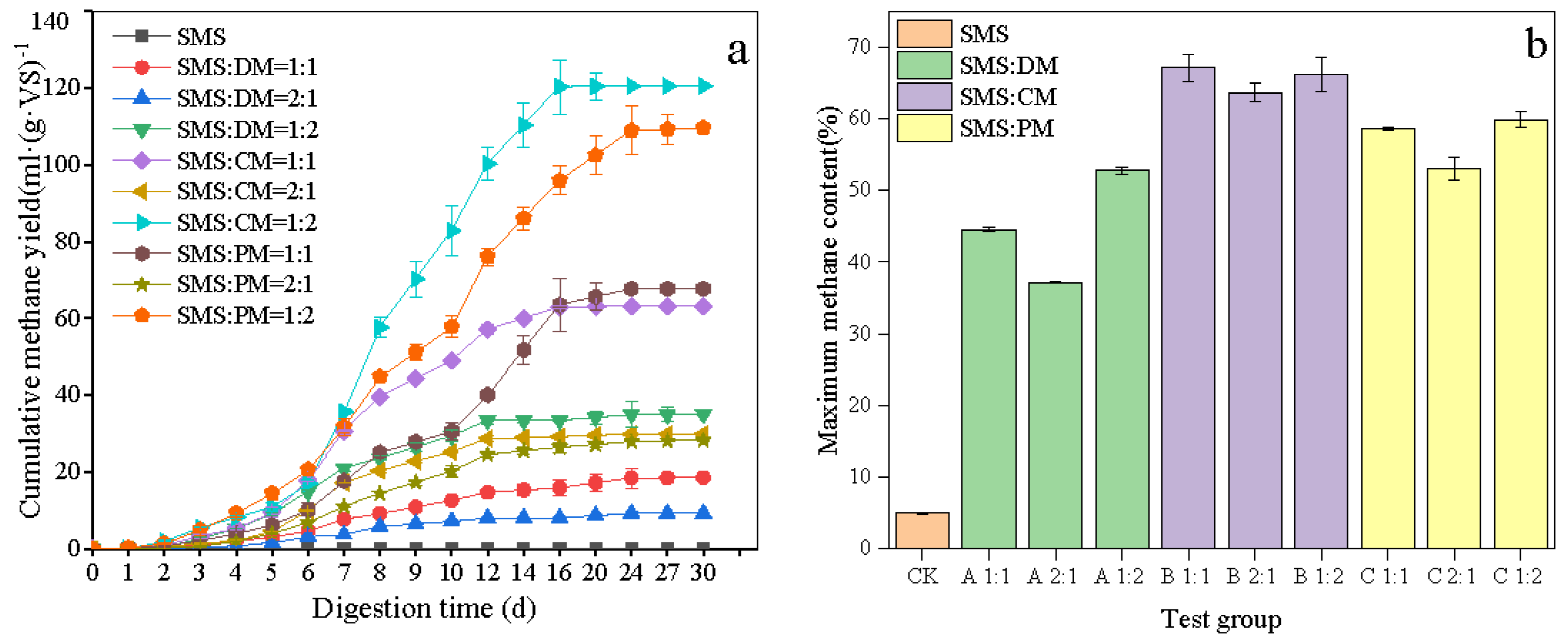
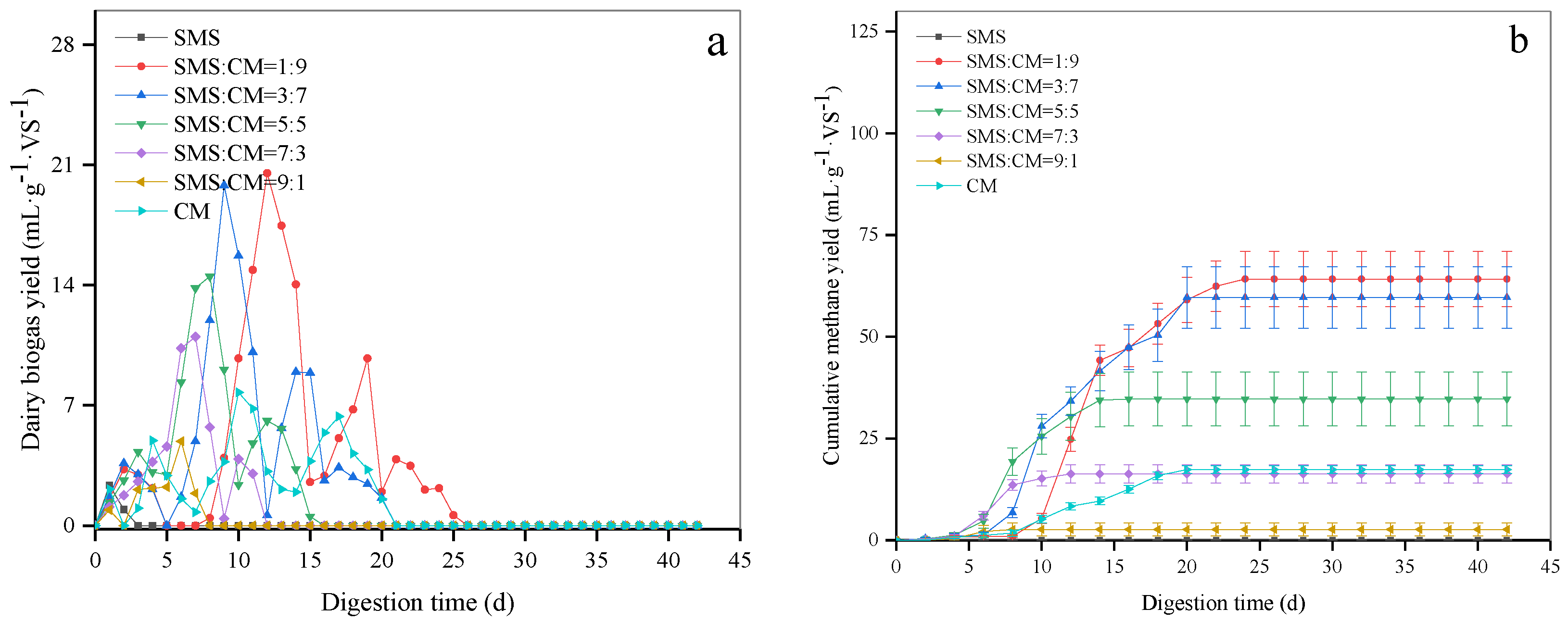
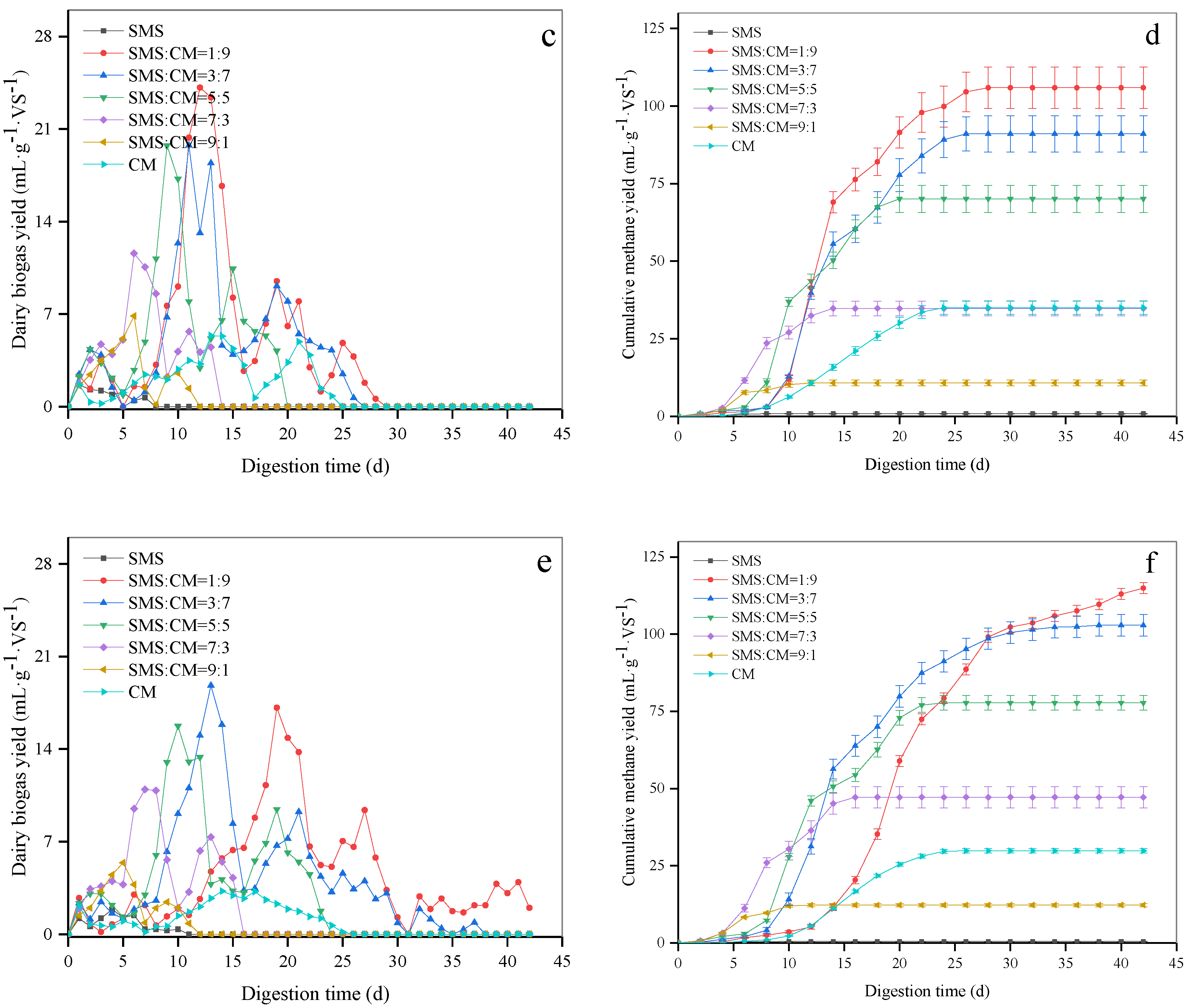
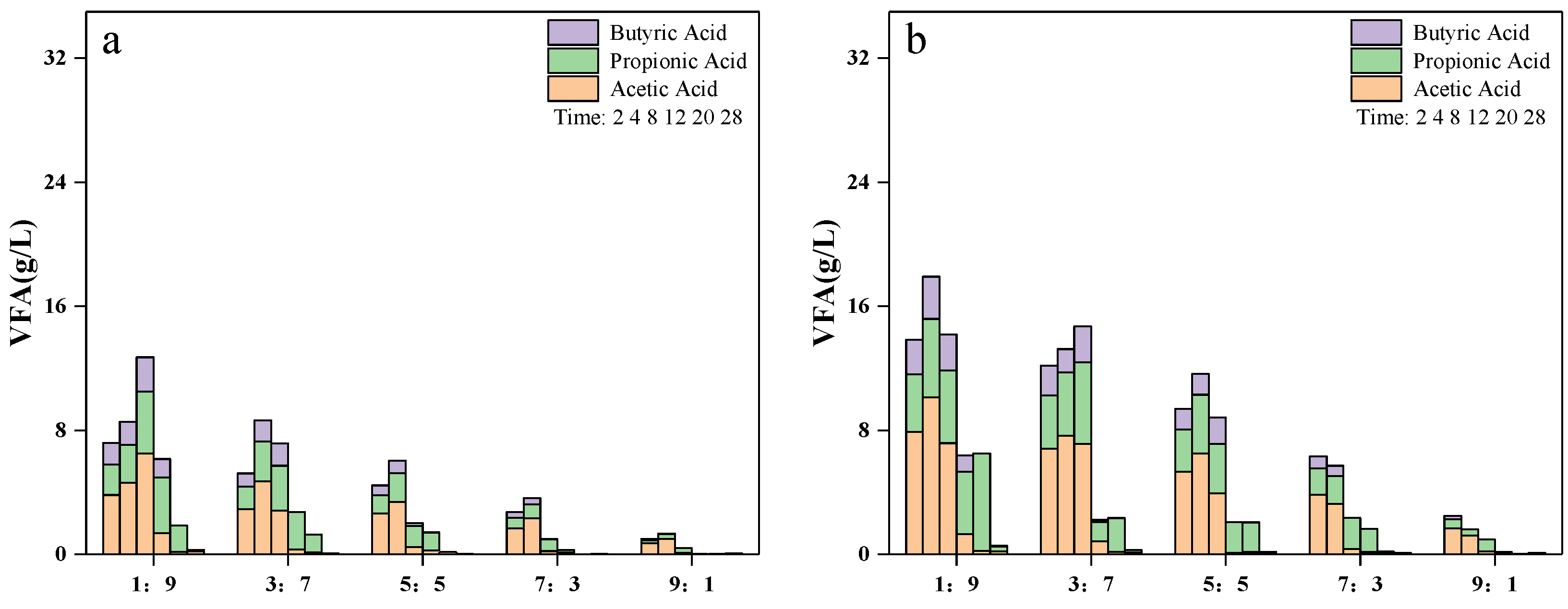
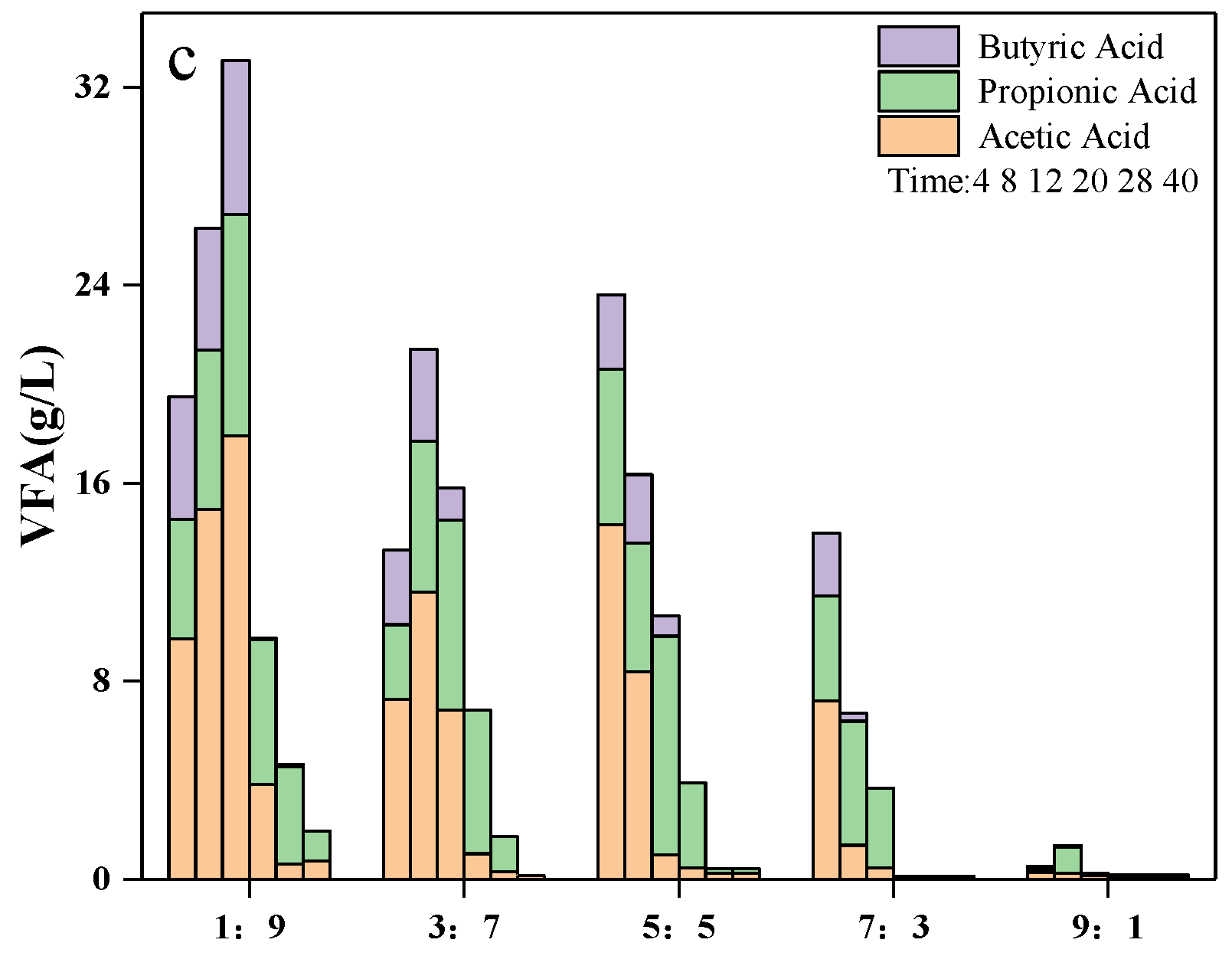
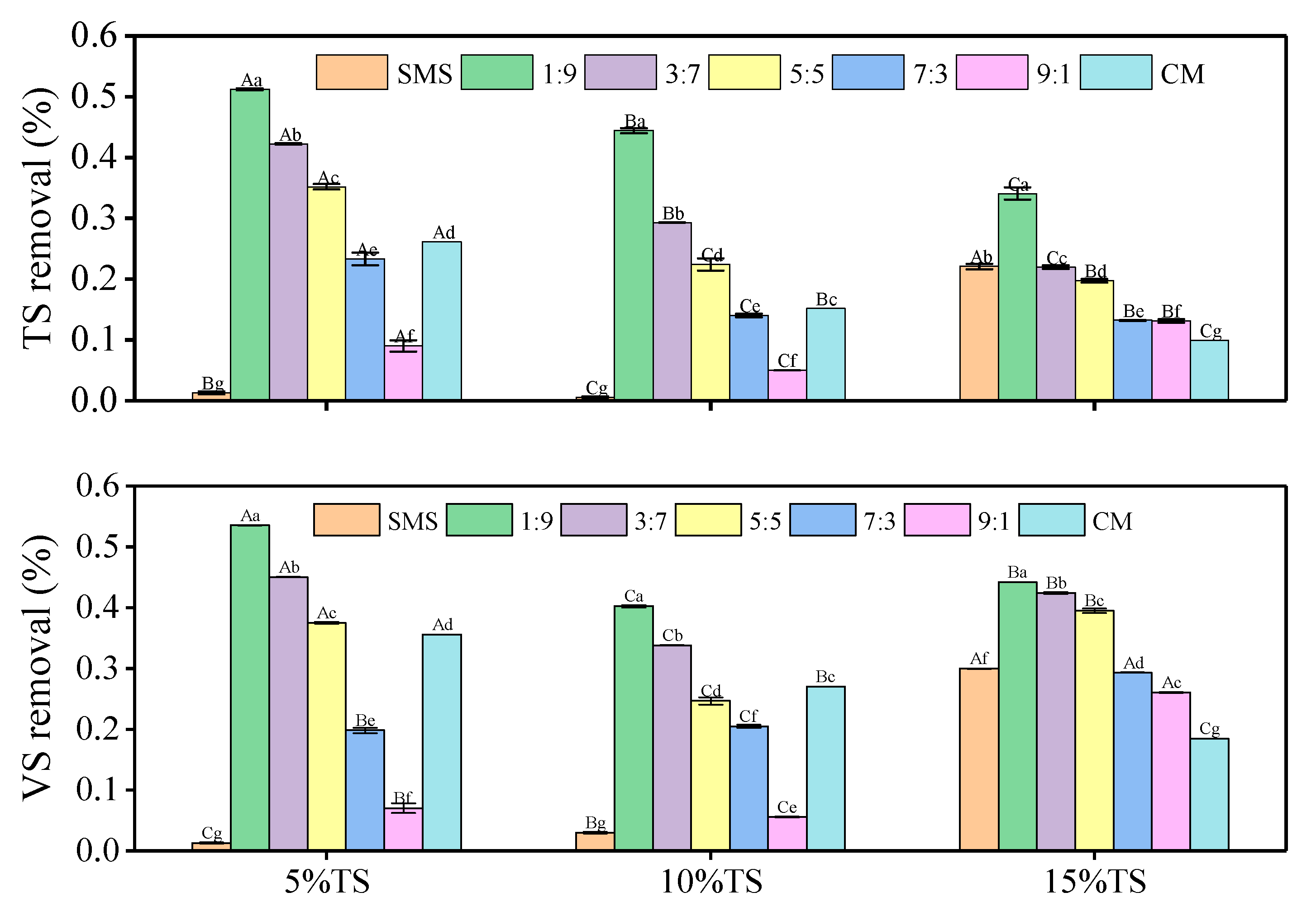
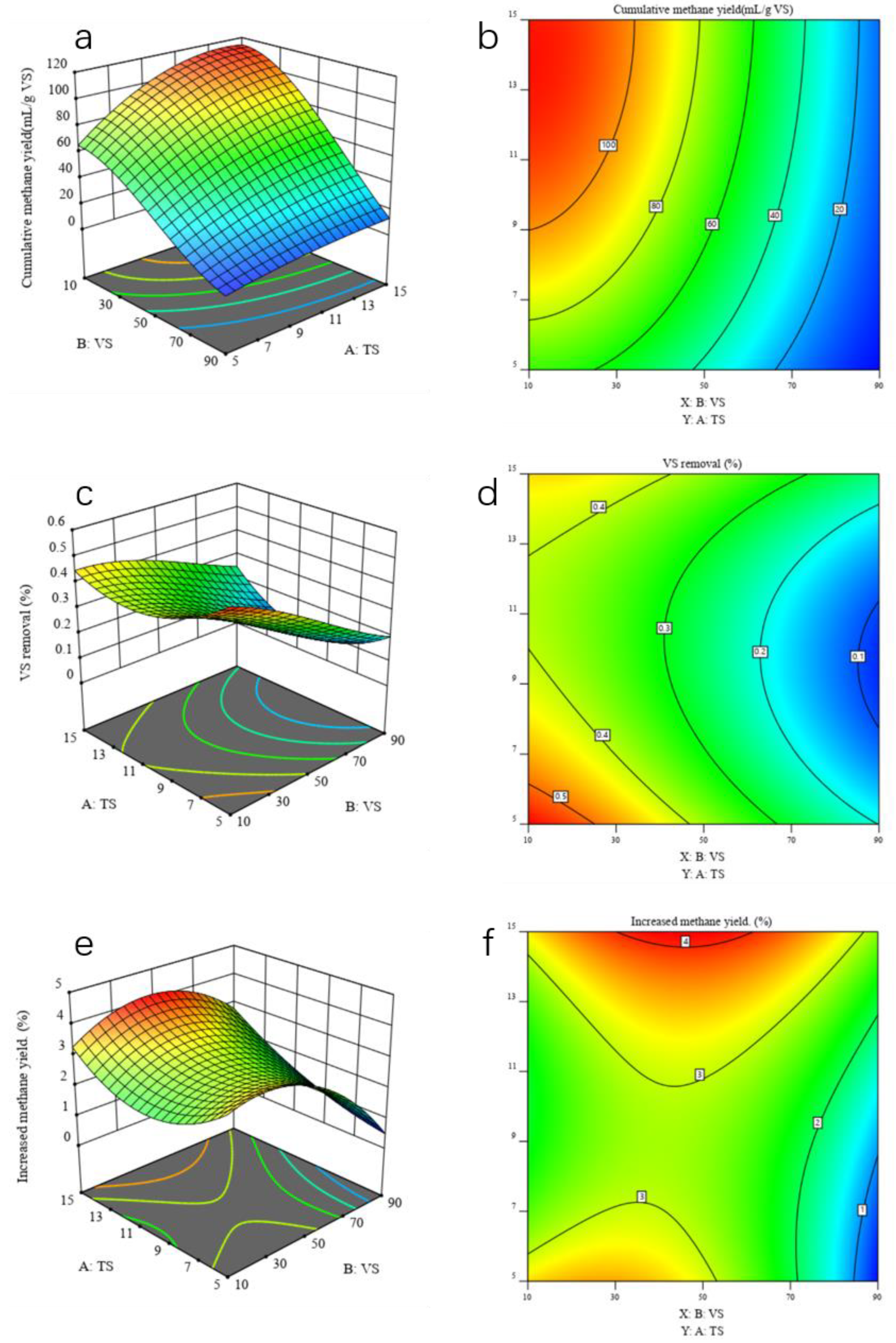
| Character | SMS | CM | DM | PM | Inoculum |
|---|---|---|---|---|---|
| TS (%) | 48.5 ± 0.01 | 19.8 ± 0.01 | 25.4 ± 0.01 | 20.8 ± 0.00 | 23.4 ± 0.88 |
| VS (%) | 32.2 ± 0.01 | 13.8 ± 0.00 | 23.0 ± 0.05 | 17.3 ± 0.00 | 11.4 ± 0.00 |
| C (%) | 28.0 | 35.9 | 41.1 | 31.5 | 24.6 |
| N (%) | 0.7 | 3.8 | 2.7 | 3.2 | 1.9 |
| C/N ratio | 36.8 | 9.3 | 15.1 | 8.8 | 22.2 |
| Glucan (%) | 8.5 ± 0.18 | 23.4 ± 0.00 | 17.2 ± 0.03 | 11.0 ± 0.57 | 4.7 ± 0.51 |
| Xylan (%) | 3.8 ± 0.07 | 15.8 ± 0.00 | 15.2 ± 0.02 | 9.2 ± 0.54 | 2.8 ± 0.30 |
| Arabinan (%) | 1.3 ± 0.01 | 5.5 ± 0.00 | 9.4 ± 0.01 | 4.7 ± 0.33 | 0.9 ± 0.03 |
| Acid-Insoluble Lignin (%) | 30.8 ± 0.01 | 10.6 ± 0.02 | 13.9 ± 0.01 | 19.8 ± 0.04 | 22. ± 0.00 |
| Treatment | Ratio of VS | Inoculum/g | Feedstock/g | |
|---|---|---|---|---|
| SMS | Manure | |||
| CG-SMS | 1:0 | 33.2 | 29.9 | 0 |
| Group A—SMS/DM | 1:1 | 37.8 | 17.0 | 47.5 |
| 1:2 | 39.6 | 11.9 | 66.4 | |
| 2:1 | 35.9 | 21.8 | 30.2 | |
| Group B—SMS/CM | 1:1 | 42.1 | 19.0 | 34.5 |
| 1:2 | 46.3 | 14.0 | 50.6 | |
| 2:1 | 38.6 | 23.2 | 21.1 | |
| Group C—SMS/PM | 1:1 | 38.7 | 17.4 | 36.6 |
| 1:2 | 41.0 | 12.3 | 51.7 | |
| 2:1 | 36.8 | 22.0 | 23.2 | |
| Design Parameters’ Designation | ||||||
|---|---|---|---|---|---|---|
| Factor | Name | Units | Type | Minimum | Maximum | Level |
| A | TS | wt.% | Ordinal | 5 | 15 | 3 |
| B | Ratio | % | Ordinal | 10 | 90 | 5 |
| Design Matrix in Coded Factors | ||||||
| Factor A | A(1) | A(2) | ||||
| 5 | −1 | 1 | ||||
| 10 | 0 | −2 | ||||
| 15 | 1 | 1 | ||||
| Factor B | B(1) | B(2) | B(3) | B(4) | ||
| 10 | −2 | 2 | −1 | 1 | ||
| 30 | −1 | −1 | 2 | −4 | ||
| 50 | 0 | −2 | −0 | 6 | ||
| 70 | 1 | −1 | −2 | −4 | ||
| 90 | 2 | 2 | 1 | 1 | ||
| TS | Treatment | B0 (mL/g VS) | μm (mL·(g·d)−1) | λ(d) | R2 |
|---|---|---|---|---|---|
| 5% | SMS:CM = 1:9 | 62.4 | 8.8 | 9.3 | 0.993 |
| SMS:CM = 3:7 | 60.0 | 6.0 | 6.2 | 0.985 | |
| SMS:CM = 5:5 | 34.8 | 6.1 | 5.1 | 0.996 | |
| SMS:CM = 7:3 | 16.3 | 4.4 | 4.5 | 0.997 | |
| SMS:CM = 9:1 | 2.7 | 1.3 | 4.2 | 0.988 | |
| 10% | SMS:CM = 1:9 | 97.4 | 13.1 | 8.9 | 0.994 |
| SMS:CM = 3:7 | 86.9 | 8.9 | 8.1 | 0.987 | |
| SMS:CM = 5:5 | 71.8 | 7.7 | 6.1 | 0.990 | |
| SMS:CM = 7:3 | 35.1 | 5.6 | 3.9 | 0.996 | |
| SMS:CM = 9:1 | 10.8 | 2.2 | 2.9 | 0.991 | |
| 15% | SMS:CM = 1:9 | 111.0 | 8.3 | 13.3 | 0.998 |
| SMS:CM = 3:7 | 102.3 | 7.9 | 7.9 | 0.996 | |
| SMS:CM = 5:5 | 78.5 | 7.1 | 6.4 | 0.992 | |
| SMS:CM = 7:3 | 47.5 | 5.8 | 4.0 | 0.993 | |
| SMS:CM = 9:1 | 12.3 | 2.3 | 2.5 | 0.996 |
| TS | Feedstock | Ratio | C/N | Methane Yield (mL/g VS) | WMP (mL/g VS) | Increased Methane Yield (%) |
|---|---|---|---|---|---|---|
| 5% | CM | Alone | 9.3 | 0.1 | None | None |
| SMS | Alone | 36.8 | 17.4 | None | None | |
| SMS-CM | 1:9 | 16.6 | 64.2 | 15.6 | 3.1 | |
| SMS-CM | 3:7 | 21.1 | 59.7 | 12.2 | 3.9 | |
| SMS-CM | 5:5 | 25.6 | 34.7 | 8.7 | 3.0 | |
| SMS-CM | 7:3 | 30.1 | 16.3 | 5.2 | 2.1 | |
| SMS-CM | 9:1 | 34.5 | 2.6 | 1.8 | 0.5 | |
| 10% | CM | Alone | 9.3 | 0.8 | None | None |
| SMS | Alone | 36.8 | 35.0 | None | None | |
| SMS-CM | 1:9 | 16.6 | 105.9 | 31.6 | 2.4 | |
| SMS-CM | 3:7 | 21.1 | 91.0 | 24.8 | 2.7 | |
| SMS-CM | 5:5 | 25.6 | 70.1 | 17.9 | 2.9 | |
| SMS-CM | 7:3 | 30.1 | 34.8 | 11.1 | 2.1 | |
| SMS-CM | 9:1 | 34.5 | 10.7 | 4.3 | 1.5 | |
| 15% | CM | Alone | 9.3 | 0.5 | None | None |
| SMS | Alone | 36.8 | 29.8 | None | None | |
| SMS-CM | 1:9 | 16.6 | 114.9 | 26.9 | 3.3 | |
| SMS-CM | 3:7 | 21.1 | 102.9 | 21.0 | 3.9 | |
| SMS-CM | 5:5 | 25.6 | 77.8 | 15.1 | 4.1 | |
| SMS-CM | 7:3 | 30.1 | 47.2 | 9.3 | 4.1 | |
| SMS-CM | 9:1 | 34.5 | 12.2 | 3.4 | 2.6 |
| Factor | Cumulative Methane Yield (mL/g/VS) | VS Removal (%) | Increased Methane Yield (%) | |||
|---|---|---|---|---|---|---|
| F-Value | p-Value | F-Value | p-Value | F-Value | p-Value | |
| Model | 370.6 | <0.0001 | 229.74 | 0.0000 | 136.65 | <0.0001 |
| A-TS | 265.7 | <0.0001 | 0.27 | 0.6068 | 76.35 | <0.0001 |
| B-Ratio | 360.3 | <0.0001 | 186.37 | 0.0000 | 33.23 | <0.0001 |
| AB | 68.2 | <0.0001 | 62.72 | 0.0000 | 120.28 | <0.0001 |
| A2 | 43.6 | <0.0001 | 397.92 | 0.0000 | 125.21 | <0.0001 |
| B2 | 33.2 | <0.0001 | 7.82 | 0.0082 | 243.70 | <0.0001 |
| A2B | 10.9 | 0.0022 | 6.06 | 0.0187 | 16.73 | 0.0002 |
| AB2 | 8.6 | 0.0060 | 1.77 | 0.1915 | 0.24 | 0.6271 |
| Residual | ||||||
| Lack of fit | 1.1 | 0.3845 | ||||
| Fit statistics | ||||||
| C.V.% | 7.9 | 5.8 | 7.4 | |||
| R2 | 0.988 | 0.981 | 0.963 | |||
| Adjusted R² | 0.985 | 0.977 | 0.956 | |||
| Predicted R² | 0.982 | 0.972 | 0.946 | |||
| Adeq Precision | 56.39 | 54.96 | 41.54 | |||
| Mean | 56.34 | 3.60 | 0.33 | |||
Publisher’s Note: MDPI stays neutral with regard to jurisdictional claims in published maps and institutional affiliations. |
© 2021 by the authors. Licensee MDPI, Basel, Switzerland. This article is an open access article distributed under the terms and conditions of the Creative Commons Attribution (CC BY) license (http://creativecommons.org/licenses/by/4.0/).
Share and Cite
Gao, X.; Tang, X.; Zhao, K.; Balan, V.; Zhu, Q. Biogas Production from Anaerobic Co-Digestion of Spent Mushroom Substrate with Different Livestock Manure. Energies 2021, 14, 570. https://doi.org/10.3390/en14030570
Gao X, Tang X, Zhao K, Balan V, Zhu Q. Biogas Production from Anaerobic Co-Digestion of Spent Mushroom Substrate with Different Livestock Manure. Energies. 2021; 14(3):570. https://doi.org/10.3390/en14030570
Chicago/Turabian StyleGao, Xionghui, Xiaoyu Tang, Kunyang Zhao, Venkatesh Balan, and Qili Zhu. 2021. "Biogas Production from Anaerobic Co-Digestion of Spent Mushroom Substrate with Different Livestock Manure" Energies 14, no. 3: 570. https://doi.org/10.3390/en14030570
APA StyleGao, X., Tang, X., Zhao, K., Balan, V., & Zhu, Q. (2021). Biogas Production from Anaerobic Co-Digestion of Spent Mushroom Substrate with Different Livestock Manure. Energies, 14(3), 570. https://doi.org/10.3390/en14030570






